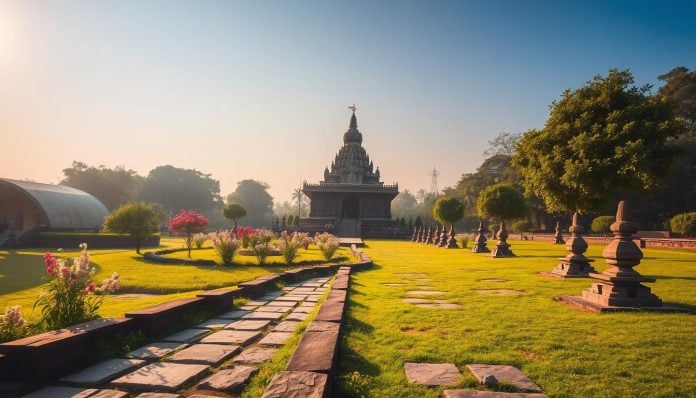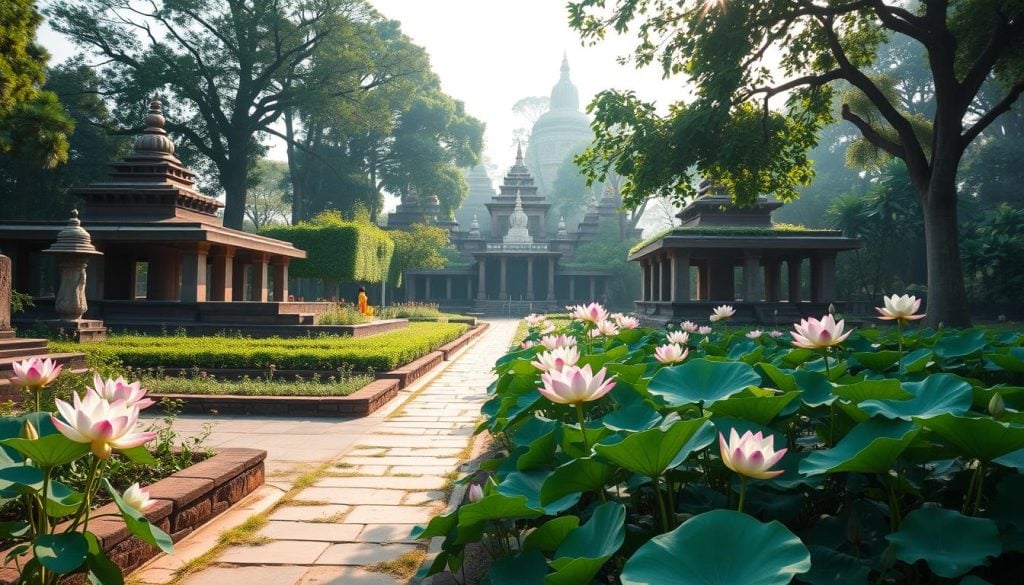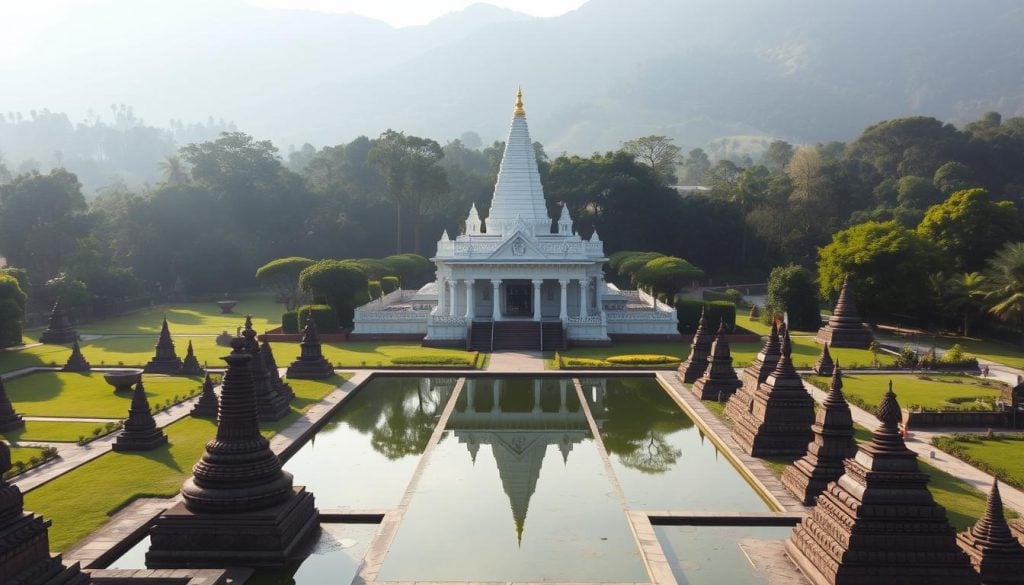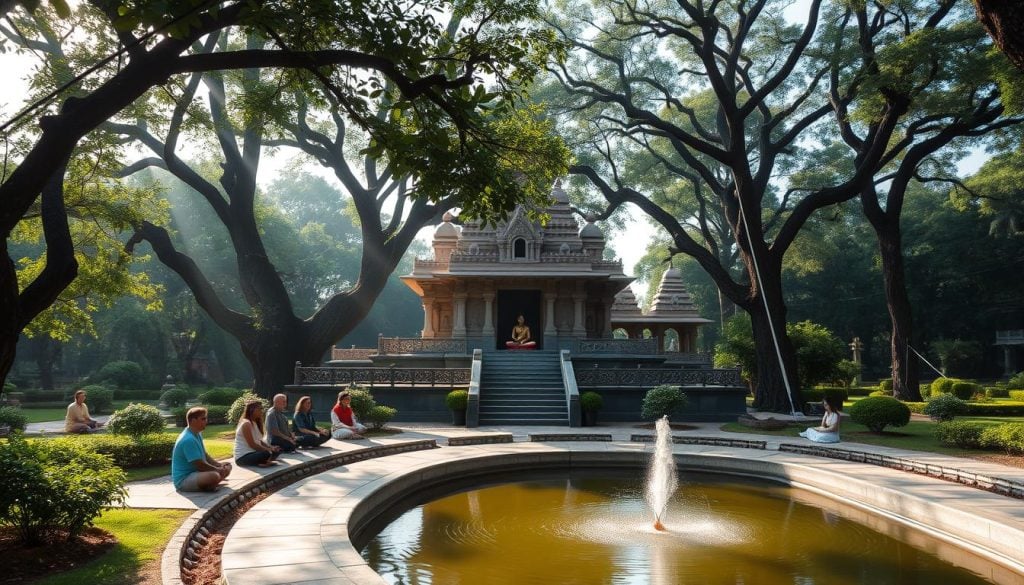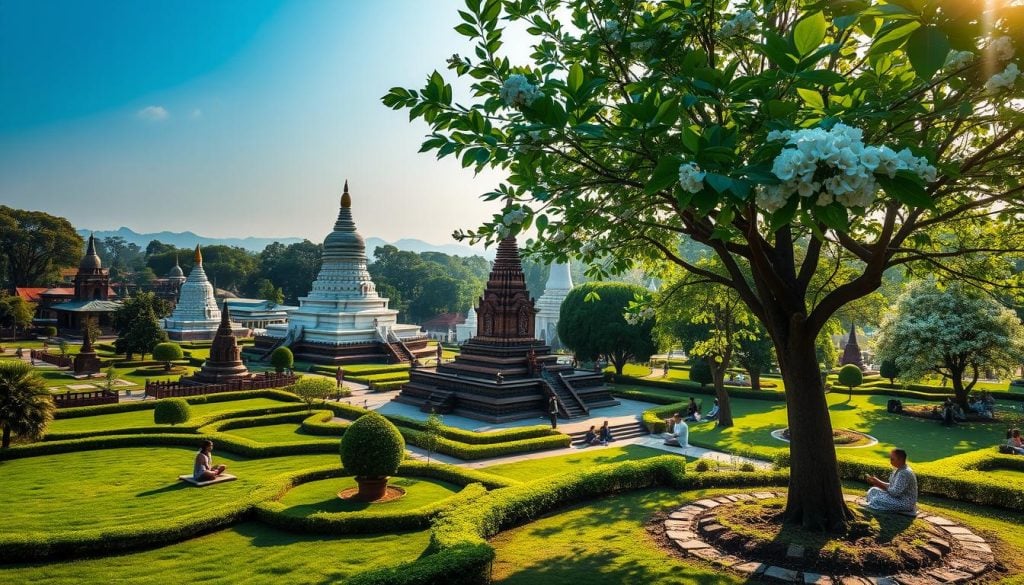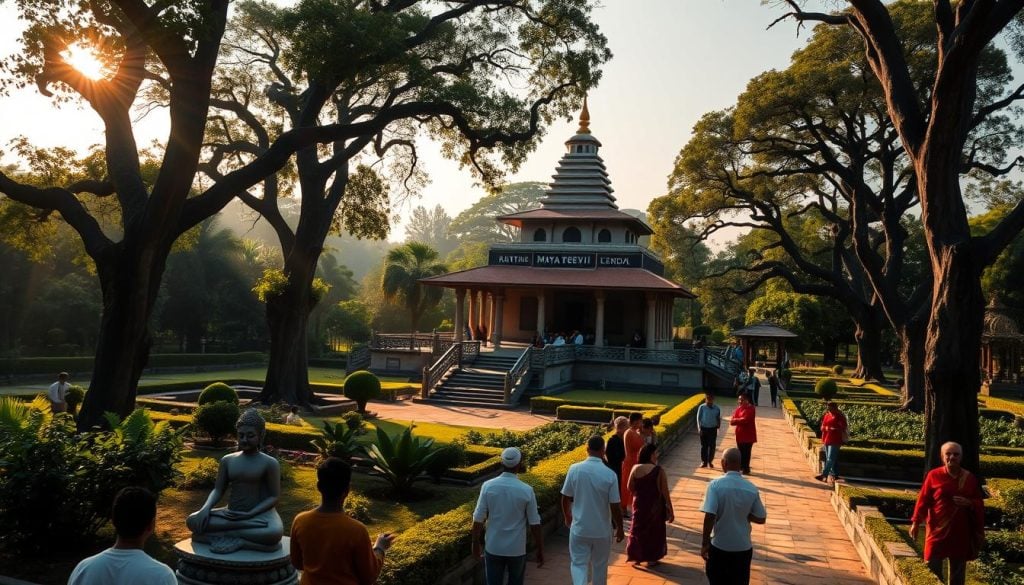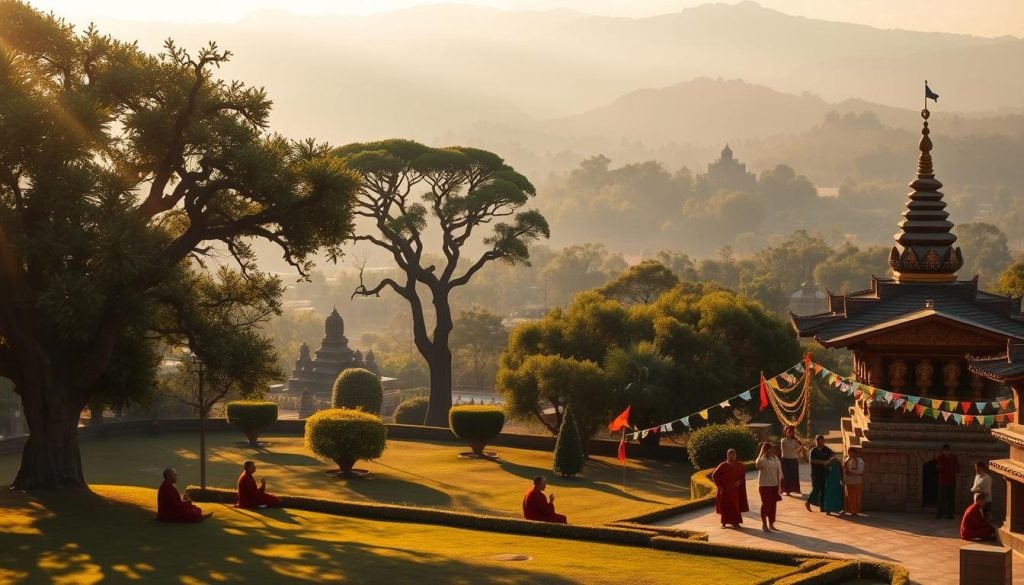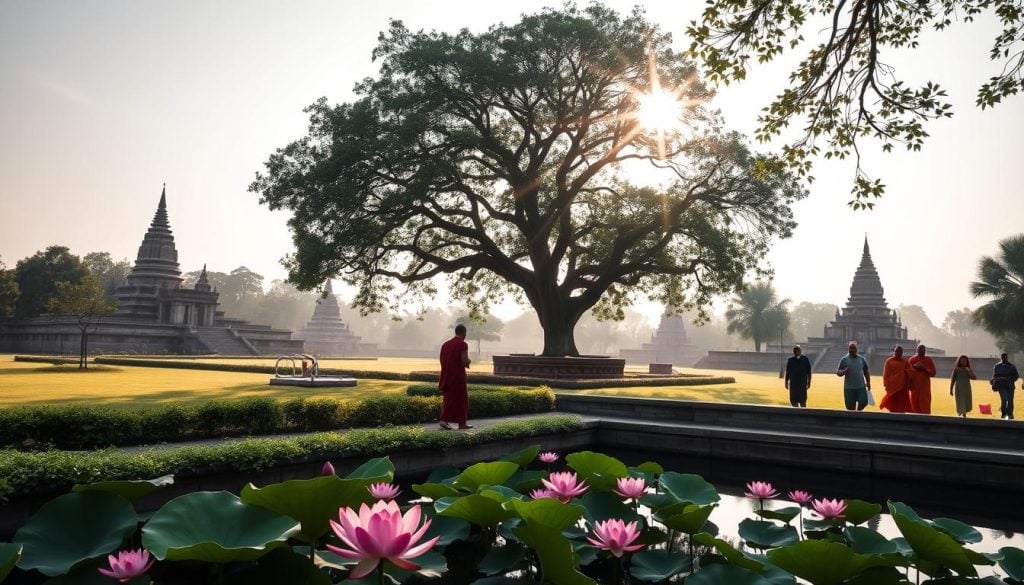Have you ever wondered why millions of seekers visit Lumbini? It’s not just a quiet place. It’s the birthplace of Buddha, filled with deep spiritual meaning. This lumbini pilgrimage site is more than ancient ruins. It’s a place where seekers find peace and enlightenment.
Walking through its grounds, you’ll feel a sense of calm. It’s a place to reflect on Buddha’s teachings. Here, you can explore the lasting impact of Buddhism.
What Is Lumbini?
Lumbini is a key lumbini sacred destination for those seeking spiritual growth. It’s located in Nepal’s lush southern plains. This place is famous as the birthplace of Siddhartha Gautama, also known as the Buddha.
It’s known for its calmness and rich history. Lumbini has ancient monuments like the Maya Devi Temple. These sites are perfect for meditation and reflection.
People visit Lumbini for its deep Buddhist significance and peaceful vibe. The ancient ruins and gardens make it a unique spot for lumbini spiritual tourism.
Exploring Lumbini, you’ll find paths to enlightenment. It’s a haven for spiritual travelers worldwide. The mix of history and spirituality offers a profound experience for all visitors.
| Category | Description |
|---|---|
| Historical Significance | Birthplace of the Buddha, a UNESCO World Heritage Site |
| Major Attractions | Maya Devi Temple, Sacred Pond, Pillar of Ashoka |
| Activities | Meditation, Pilgrimage, Cultural Exploration |
| Cultural Influence | Represents unity among diverse Buddhist traditions |
| Accessibility | Easily reachable from major cities in Nepal |
Historical Overview of Lumbini
Lumbini’s history goes back over 2,500 years, making it a key site in lumbini religious significance. It is famous as the birthplace of Siddhartha Gautama, later known as the Buddha. Queen Maya Devi gave birth to him under a sal tree, starting Buddhism’s journey.
Over time, Lumbini caught the eye of powerful dynasties like the Mauryas and Kushans. They helped spread Buddhism, enriching the lumbini buddhist heritage. The Ashoka Pillar, built by Emperor Ashoka in 249 BCE, stands as a symbol of Lumbini’s importance. It shows the area’s commitment to Buddhism’s teachings and traditions.
Visiting Lumbini connects you deeply with history. This site tells the story of Buddhism and its teachings. It’s a place where you can find spiritual growth.
The Maya Devi Temple: Heart of Lumbini
The Maya Devi Temple is a key part of the lumbini spiritual journey. It captures the essence of Buddhist heritage. This site marks the birthplace of Buddha and is known for its beautiful architecture.
Visitors can feel the deep energy in the temple. It invites moments of reflection and connection.
Architectural Significance of the Temple
The Maya Devi Temple’s architecture is rooted in ancient styles. It shows intricate designs that carry spiritual meaning. The temple’s structure and peaceful surroundings are perfect for meditation and prayer.
It reflects the artistic traditions of the time and honors Buddha’s life. Each part of the temple has its own story, making the lumbini spiritual journey richer.
The Sacred Marker Stone
At the temple’s heart is the sacred marker stone. It marks the spot where Buddha was born. This stone is more than a marker; it represents the spiritual lineage and teachings of Buddhism.
Pilgrims gather around it for practices that deepen their connection. This moment in history enriches their lumbini spiritual journey.
Key Spiritual Practices in Lumbini
Lumbini is a place of peace for those on a spiritual journey. It offers many ways to learn about Buddhism. You can meditate in the beautiful gardens, finding calm and connecting with yourself.
There are mindfulness exercises to help you stay present. These happen in the green gardens, creating a perfect setting for thought and reflection.
Joining in traditional rituals with monks is a special experience. It lets you see how Buddha’s teachings work today. You get to learn from those who live by these teachings every day.
- Meditation in sacred gardens
- Mindfulness exercises
- Silent reflection opportunities
- Engagement with monastic communities
- Traditional rituals participation
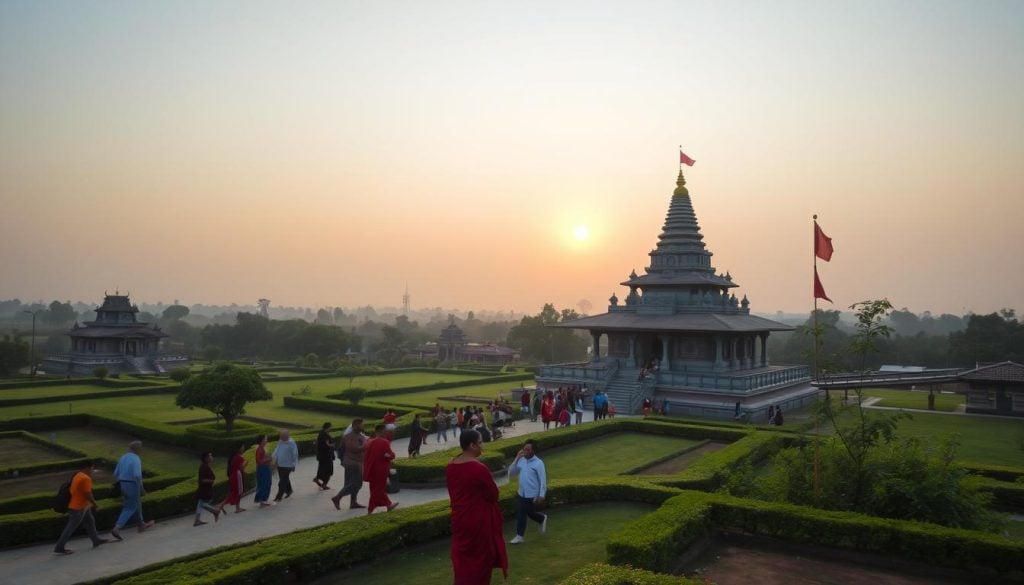
Monastic Diversity in Lumbini
Lumbini is a key spot for spiritual tourism and shows the wide reach of Buddhist heritage. It has many monasteries that show how Buddhism is practiced around the world. Each one offers a glimpse into different traditions and beliefs.
Exploring Different Buddhist Traditions
The monasteries in Lumbini are varied and rich. You’ll find places from Thailand, China, and Japan, each with its own culture and view of Buddhism. This mix creates a welcoming space for those looking to learn about Buddhism.
Architectural Styles of the Monasteries
The buildings of these monasteries add to Lumbini’s beauty. Each one has its own story in its design, colors, and layout. Here’s a look at some:
| Monastery | Country | Architectural Style | Distinct Features |
|---|---|---|---|
| Thai Monastery | Thailand | Traditional Thai | Intricate carvings, gold accents |
| Chinese Monastery | China | Chinese Pagoda | Elegant roofs, serene gardens |
| Japanese Monastery | Japan | Zen Buddhist | Minimalist design, harmonic nature integration |
Lumbini’s Sacred Gardens and Meditation Spaces
Visiting Lumbini lets you explore its lumbini sacred destination. You’ll find peaceful gardens that help you find inner peace. The gardens have winding paths that lead you to quiet spots for thinking.
Each area is filled with colorful plants and soft streams. This creates a calm atmosphere that encourages mindfulness.
The gardens are key for personal spiritual journeys. Walking among the plants and listening to nature can connect you with your inner self. The calm around you makes it easy to reflect and grow spiritually.
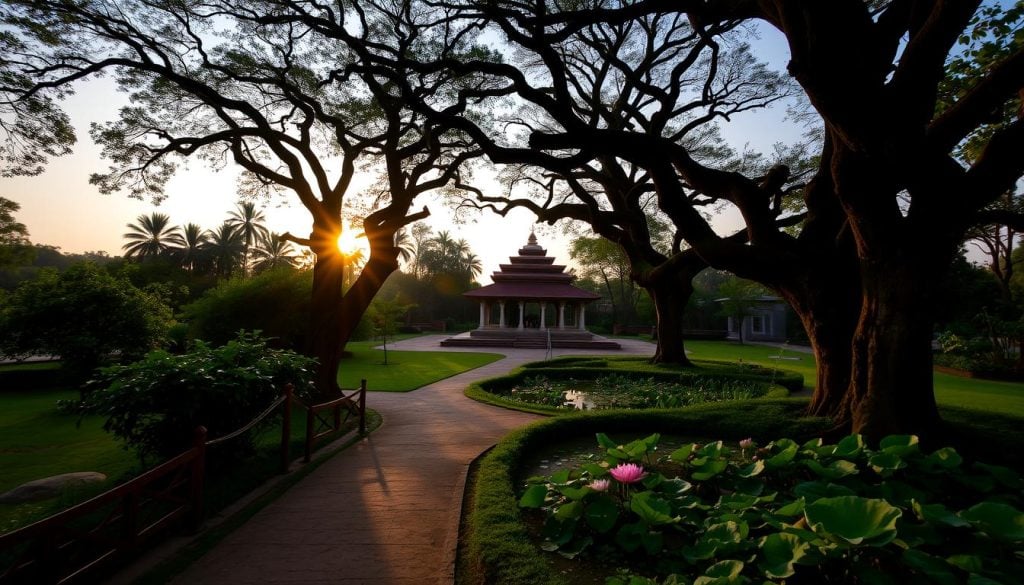
The gardens’ design invites you to explore and learn. You can meditate or just enjoy the beauty around you. It’s a great place for spiritual growth, making Lumbini a special lumbini sacred destination for seekers of enlightenment.
Lumbini Spiritual Significance
Lumbini is deeply connected to Buddha’s teachings. It shows us the importance of compassion, peace, and mindfulness. As you explore this sacred place, you’ll feel the spiritual significance of Lumbini. It touches the hearts of seekers from all over the world.
Connection to Buddha’s Teachings
Lumbini is where Buddha’s teachings come alive. Every step here invites you to reflect on his life and teachings. People often meditate and practice mindfulness, gaining a deeper understanding of these principles.
Whether you’re experienced in spirituality or new to it, Lumbini’s peaceful atmosphere enriches your journey. It shows us how to live a more mindful life.
Impact on Modern Spirituality
Lumbini’s influence goes beyond its history. Today, many find inspiration in Buddha’s teachings. People come to Lumbini seeking peace and purpose.
This place reminds us that spiritual growth is possible. It encourages us to apply Buddha’s teachings to our daily lives. Lumbini’s spiritual significance brings together a global community focused on compassion and peace.
| Key Teachings | Modern Application |
|---|---|
| Compassion | Promotes empathy in personal relationships |
| Mindfulness | Incorporated into daily routines through meditation |
| Peace | Encourages conflict resolution and harmony |
| Self-awareness | Fosters personal growth and understanding |
Cultural Experiences and Local Interaction
Exploring Lumbini’s local culture makes your trip even more special. You can meet dedicated monks who share their spiritual practices and the site’s history. Their stories help you understand Lumbini’s deep cultural meaning.
Joining in on traditional ceremonies is a unique experience. These lumbini cultural experiences let you join in rituals. It’s a great way to connect with Buddhist traditions and make lasting memories.
Visiting local markets is also a highlight. You can try authentic Nepali food and see handicrafts that show off the region’s culture. It’s a way to dive into local customs and enjoy the flavors of Lumbini.
Don’t miss out on community events or workshops. They showcase local art and music. These experiences give you a deeper look into Lumbini’s culture and create unforgettable moments.
Practical Tips for Visiting Lumbini
Planning a trip to Lumbini needs careful thought for a great experience. Book your stay early. You’ll find many choices, from simple guesthouses to hotels.
Dress modestly when you visit. It shows respect and makes your visit better. Exploring carefully helps you connect with the site’s deep meaning.
Guided tours add a lot to your visit. Guides share important history and insights. They turn your trip into a memorable journey.
| Tip | Description |
|---|---|
| Book Accommodations Early | Secure your stay to find options that fit your budget and preferences. |
| Dress Modestly | Wear respectful clothing that aligns with the sacred nature of the site. |
| Explore Mindfully | Take your time to absorb the beauty and significance of the surroundings. |
| Join Guided Tours | Enhance your visit with expert knowledge and historical insights. |
Conclusion
Lumbini is a special place where the Buddha was born. It’s more than a tourist spot; it’s a place for deep spiritual discovery. The calm surroundings, filled with history and culture, are perfect for reflection and connecting with Buddha’s teachings.
Walking through the sacred gardens and experiencing the different monastic traditions is transformative. Each step in Lumbini can lead to a life-changing experience. This site is a key place for those seeking spiritual growth.
Exploring Lumbini’s rich heritage helps you understand its spiritual importance. This birthplace of Buddhism invites you to explore your own spiritual path. It encourages growth and enlightenment as you journey along.

































